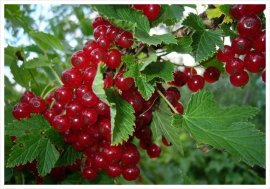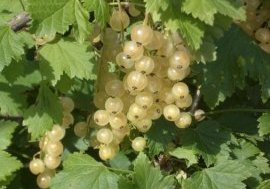
Red Snotlout
 If the black smorid first started to cultivate the Kyiv Russy monks in the twentieth century, the reds were raised by Dutchmen in the first century. The most interesting thing is that they brought her in as a culture not for the harvest of the berries, but for her decorational qualities to make it beautiful in the gardens. So in Europe, she was popular with a lot more black sorodine. It became known in Rusi since the fifteenth century.
If the black smorid first started to cultivate the Kyiv Russy monks in the twentieth century, the reds were raised by Dutchmen in the first century. The most interesting thing is that they brought her in as a culture not for the harvest of the berries, but for her decorational qualities to make it beautiful in the gardens. So in Europe, she was popular with a lot more black sorodine. It became known in Rusi since the fifteenth century.
The Red and White Smorodine are not as sympathetic as black, as the air oils are smaller, but also very delicious and useful. It makes a great jelly, even without adding a desirabler at the expense of a high peck content. An uncomfortable, long-lived red tumor is a sinful man of most of our gardens.
The white smoordin started to cultivate much later. Even at the beginning of the twentieth century, she was considered to be a red sorodine with a non-optic colour of the berries.
 Contemporary horticulture was created in time by three different species. But for some reason, red and white smorid are always seen as one culture, because they have a fundamental difference in the color of the berries. The now recognized leader of the red and white sorodine is the United States.
Contemporary horticulture was created in time by three different species. But for some reason, red and white smorid are always seen as one culture, because they have a fundamental difference in the color of the berries. The now recognized leader of the red and white sorodine is the United States.
There's another completely separate species, a golden, erroneously attached to white. This species is of North American origin, grows closer to southern latitudes and is markedly different from its natural habits.
Red Snotled
Smorodine's red and white likes soup and dryland soils, but it can also grow on others. Svetol loving is more than black, but not so demanding to humidity, but it can be multiplied by bush and releasing, green and curled hairs (blacking for red and white is less effective).Save the red smorid is the most early autumn in September. The Yama is pumped in advance so that the soil is settled. The pit range is 50 cm, depth 40 cm. Between plant and plant, leave spaces up to 1, 5 m.
 After landing, the land needs to be cleaned up, so there's no void, and water the cave. Sagers need to be severely cut, leaving 10 to 15 cm from land with 2 to 3 kidneys, and well seal the soil around.
After landing, the land needs to be cleaned up, so there's no void, and water the cave. Sagers need to be severely cut, leaving 10 to 15 cm from land with 2 to 3 kidneys, and well seal the soil around.
Red Snotlout
In winter resistance and resilience to mushroom diseases, red and white blemordin exceeds black. It is not particularly demanding to the moisture, but it needs to be dried periodically, especially during the fetus. You'll have to lose the sormon from the weeds, which, by their powerful roots, can do a lot of damage.Red sorodine should be fed up: chloride and superphosphate are introduced in the fall and nitrogen fertilizers in the spring.
To give rich crops with large berries, it must be cut. The cut shall be made in the fall or in the early spring (before the coding). A sanitary cut may also be carried out in the summer after the period of fertility.
The Red Smorodine is different from the black part of the fetus: the fruit kidneys are formed at multi-year runs and at the base of the annual branches. The bites of red and white are much smaller than the black sorodine's, they're lighter and fertilized much longer - 15-20 years. Bracketed branches and rings on which the flower kidneys are planted live 2-3 times longer than the black sorodine. The distribution of the berry by bit is more even, with the age of harvest, does not change to the periphery of the crown. So the red and white sops need a smaller cut.


Share this Post
Related posts
Heat Cucumbers
For the first fifteen days, the cucumbers need enhanced care and nitrogen food, and after the flower begins, nitrogen is…
Read MoreAll Kinds Of Cabbage
It s in the middle of the day, and it s the best of the business. All the windows have been set up with a variety of stitches…
Read More









